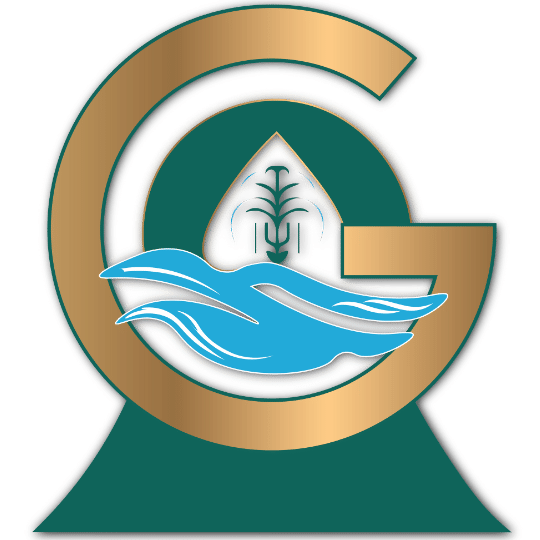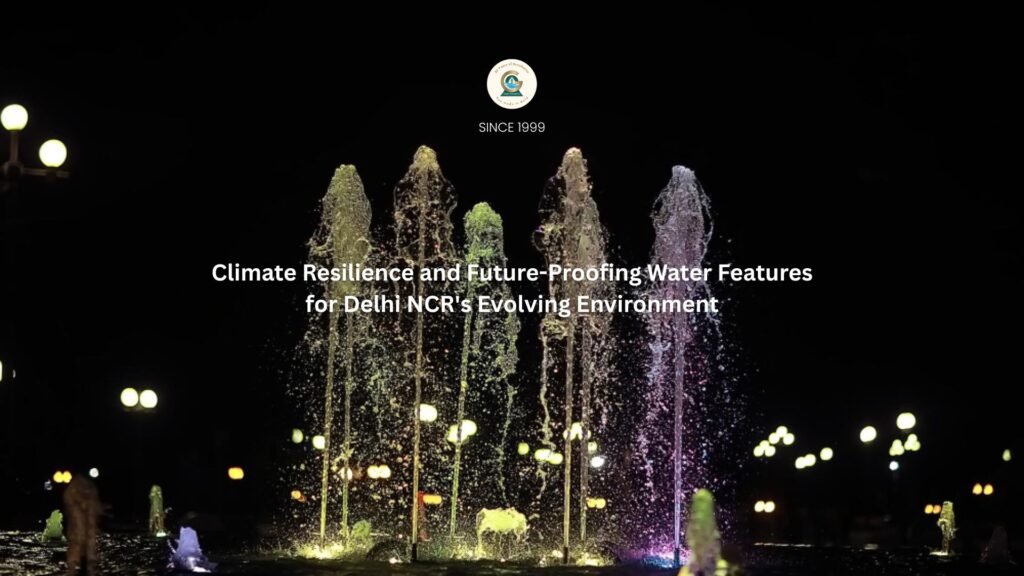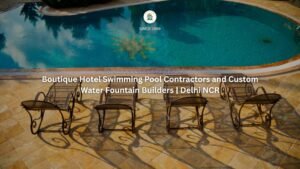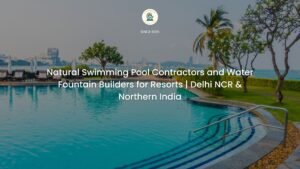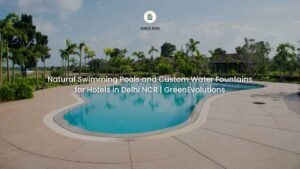Introduction: Designing for Uncertainty in a Changing Climate
Delhi NCR’s environment is changing rapidly, presenting water feature designers with unprecedented challenges that require rethinking traditional approaches to aquatic installations. Rising temperatures, shifting precipitation patterns, increased air pollution, and extreme weather events demand design strategies that anticipate rather than merely respond to environmental changes.
The most forward-thinking property owners and developers now recognize that water features must serve dual purposes: enhancing current property value and appeal while adapting successfully to climate conditions that will emerge over the next 20-30 years of operational life.
Climate Change Impacts on Water Feature Design
Temperature Extremes and System Stress
Delhi’s summer temperatures now regularly exceed historical design parameters, creating evaporation rates and thermal stress that overwhelm traditionally designed systems. Future installations must anticipate continued temperature increases while providing enhanced cooling benefits.
Precipitation Pattern Changes
Traditional monsoon patterns have become less predictable, with more intense rainfall events followed by longer dry periods. Water features must handle increased stormwater volumes while operating efficiently during extended drought conditions.
Air Quality Deterioration
Worsening air pollution accelerates material deterioration while creating greater need for air quality improvement through water feature operation. Advanced systems serve dual purposes as aesthetic elements and environmental remediation tools.
Adaptive Design Strategies
Modular and Expandable Systems
Future-proof installations incorporate modular design principles that allow expansion, reconfiguration, or technology upgrades without complete reconstruction. This flexibility enables adaptation to changing user needs and environmental conditions.
Smart Controls and Responsive Systems
Intelligent water features adapt automatically to environmental conditions through sensors that monitor temperature, air quality, precipitation, and energy costs, optimizing operation for efficiency and performance.
Energy Independence and Renewable Integration
Solar power, battery storage, and energy-efficient components provide operational independence that becomes more valuable as energy costs rise and grid reliability faces increasing stress.
Water Conservation and Efficiency
Closed-Loop Systems and Recycling
Advanced water management minimizes consumption through sophisticated recycling, rainwater harvesting, and greywater integration that operates independently of municipal water supplies during shortages.
Drought-Resistant Design
Features that maintain visual appeal during water restrictions or drought conditions ensure continued property value and aesthetic function regardless of water availability challenges.
Urban Heat Island Mitigation
Evapotranspiration Cooling Systems
Strategic water feature placement and design can provide measurable cooling effects that counteract urban heat island intensification while reducing air conditioning loads.
Microclimate Creation
Well-designed installations create localized environmental improvements that provide refuge from increasing urban heat while supporting human comfort and well-being.
Integration with Green Infrastructure
Ecosystem Services and Biodiversity
Future water features serve ecological functions that support urban wildlife, air quality improvement, and stormwater management while maintaining aesthetic and recreational value.
Carbon Sequestration and Climate Benefits
Biological components of advanced water features contribute to carbon capture while providing oxygen generation and air purification that become increasingly valuable in urban environments.
Technology Evolution and Smart Systems
Artificial Intelligence and Predictive Management
Machine learning systems optimize water feature operation based on weather predictions, usage patterns, and efficiency targets while providing predictive maintenance that prevents failures.
Internet of Things Integration
Connected sensors enable remote monitoring, automated adjustments, and integration with broader smart building and city systems that optimize resource usage and performance.
Economic Resilience and Value Protection
Operational Cost Management
Rising energy and water costs require installations that become more efficient over time rather than more expensive to operate as infrastructure ages.
Market Value Protection
Properties with climate-resilient features maintain value better during environmental stress while appealing to increasingly environmentally conscious buyers and tenants.
Health and Wellness Benefits
Air Quality Enhancement
Water features provide measurable air quality improvements that become more valuable as urban air pollution worsens and health awareness increases.
Stress Reduction and Mental Health
Natural water elements provide psychological benefits that become more important as urban environments become more stressful and technology-dominated.
Regulatory Adaptation and Compliance
Environmental Regulations
Anticipating stricter environmental regulations ensures installations remain compliant while potentially qualifying for incentives that reward sustainable design.
Building Standards and Certification
Advanced water features contribute to green building certification and sustainability ratings that influence property values and marketability.
Implementation Strategies for Future-Readiness
Risk Assessment and Planning
Comprehensive analysis of climate risks, regulatory changes, and technological evolution informs design decisions that provide long-term value and adaptability.
Phased Development and Upgrades
Strategic implementation allows initial installation with planned upgrade pathways that adapt to changing conditions and emerging technologies.
Performance Monitoring and Optimization
Continuous monitoring enables optimization and adaptation over time, ensuring installations continue providing value as conditions change.
Conclusion: Strategic Investment in Uncertain Times
Climate change and urban development create both challenges and opportunities for water feature design. Properties that invest in climate-resilient, adaptive installations will maintain competitive advantages while contributing to environmental solutions that benefit entire communities.
The most successful future installations will serve multiple purposes: aesthetic enhancement, environmental remediation, climate adaptation, and community resilience. For property owners and developers, understanding these interconnected benefits ensures water feature investments provide lasting value in an uncertain but promising future.
